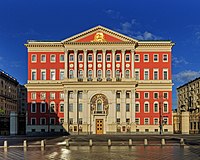Vosnesensky Alley
The Voznesensky Lane ( Russian Вознесенский переулок ) is a 650-meter-long street in the Central Administrative District of Moscow . It leads from Great Nikitskaya Street to Tverskaya Street .
history
The old street was called "Novgorodski-Gasse" in the 15th century because of the Novgorod community that had settled here. At the beginning of the 16th century a wooden Ascension Church was built here. In its place, Tsar Fyodor Ioannowitch had the Ascension Church built on Nikitskaya in 1584 . So the street got the name "Vosnesenski" ( Vosnessenije means "Ascension").
In 1782 General Field Marshal Count Sachar Tschernyschow became Governor of Moscow. In the same year, a residential palace was built for him at the intersection of the alley with Tverskaya Street. So the street was named Große-Tschernyschowski-Gasse. The architectural ensemble of the alley consists essentially of buildings from the 18th and 19th centuries. The Anglican Church of St. Andrei is also located here . In 1922, the street was renamed Stankewitscha-Straße in memory of NW Stankevich who lived here. In 1994 the street got the name "Vosnesenski" again.
description
At the intersection of the alley with Great Nikitskaya Street is the Church of the Assumption of Christ on Nikitskaya , which was built in 1584 in place of a former wooden church. It was rebuilt and restored several times, for example in the 1680s, from 1737 to 1739 after a fire, in 1764, at the beginning of the 19th century and in 1876. In 1932, under Soviet rule, and until it was returned to the Russian Orthodox in 1992 Church it was closed to church services and was instead used by various organizations.
The church has a bell tower, and is surrounded by an 18th century wall. Since the first half of the 19th century, when another large Ascension Church was built nearby in Nikitsakaja Street, the old church was given the colloquial name "The Little Ascension" (Russian Maloje Vosnessenije )
Chernyshev's mansion at the intersection with Tverskaya Street is now the Moscow City Hall. It was bought by the Moscow government after Chernyshev's death. The originally three-storey classical building survived two major fires in 1812 and 1823 and was reconstructed three times before the revolution. From 1929 to 1930 it was rebuilt again by Iwan Fomin .
The planned strong broadening Tverskaya Street made a rewind displacement required of the building about 13 meters. On September 16, 1939, the approximately 20,000-ton building, which was fastened with a metal skeleton, was moved to the new foundation within 41 minutes without interruption, a world record for the speed at which buildings were moved. From 1945 to 1947 an extensive renovation took place under the direction of Dmitri Chechulin . The construction was fortified again, two floors of the building were rebuilt and decorated by Nikolai Tomski .
On the street there are among others:
- House number 6/3. Corps 1. The old mansion from the 18th century originally belonged to Alexander Sumarokov's grandfather . In the 19th century Alexander Pushkin , Pyotr Vyazemsky and Denis Dawydow were guests here. The architect Iwan Scholtowski lived here from 1923 to 1959 .
- House number 8/5. The ensemble of the Anglican Church of St. Andrej. The only Anglican church in Moscow was built in 1882-1884 according to the plan of the architect Richard Freeman. The single-aisled basilica in Victorian style has a tower that does not have bells. Under Soviet rule, the church was closed to worship. At the request of Elizabeth II during her visit to Moscow in 1994, Boris Yeltsin arranged for the building to be returned to the community. In 2017, the Archbishop of Canterbury Justin Welby paid a visit. The first organ in the church has not survived. A second organ was installed in early 2019. Next to the church there is a two-story house for the chaplain . The church has a library and a Sunday school . Services are conducted in English.
- House number 9th Corps 4th home of Pyotr Vyazemsky. Alexander Pushkin read his tragedy Boris Godunov here for the first time in 1826 ; he lived here in 1830.
Web links
Individual evidence
- ↑ Сытин П. В. Откуда пошли названия улиц Москвы. —М .: Московский рабочий, 1959 - С. 284
- ↑ Портал открытых данных Правительства Москвы. Объекты культурного наследия.
- ^ Church website
Coordinates: 55 ° 45 ′ 33.8 " N , 37 ° 36 ′ 19.8" E



